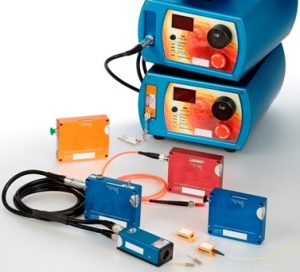
The correct Raman laser is especially important for Raman spectroscopy when compared with other spectroscopic techniques because the Raman shift is directly related to the light source and the measured spectroscopic data cannot be decoupled from the light source. The Raman Effect is a very weak effect and is directly proportional to the power of the light source.
The strength of the Raman signal is also tied to the specific wavelength used:
- Longer wavelengths give weaker Raman signal but have less (or no) fluorescence
- shorter wavelengths give exponentially stronger Raman signal but may also have much higher fluorescence that can drown out the Raman signal.
A Raman light source must also have narrow linewidth and very good wavelength stability and predictability as it must always be within the tolerances of the filters. See our new Lasers 101 page for information on the specification needed in Lasers.
Today, diodes are the most popular choice for Raman excitation, but this was not always the case because traditional diode lasers have a high degree of uncertainty in their center wavelength are typically specified with a +/- 5 nm tolerance. In Raman spectroscopy, this is completely unacceptable as precise knowledge of the starting wavelength is required to accurately measure the shift in the energy of the scattered photon.
The Right Raman Lasers:
RPMC Lasers is able to offer a practical Raman source with a volume Bragg grating (VBG)-based hybrid external cavity diode laser (HECL) in both multimode and single mode with +/- 0.5 nm or +/- 0.1 nm wavelength tolerance and very narrow linewidth. These Raman spectroscopy sources are available in a variety of wavelengths, output configurations, and packaging configurations.
RPMC’s proprietary Wavelength Stabilized Lasers feature high output power with ultra-narrow spectral bandwidth. The laser’s stabilized peak wavelength remains “locked” regardless of case temperature (10 to 35 deg. C). These devices can be spectrally tailored to suit your application needs and offer side mode suppression ratios (SMSRs) better than 40 dB, thereby providing an extremely high signal to noise ratio and making these sources ideal for Raman spectroscopy.
Single mode and Multimode options are available. Our wavelength stabilized lasers feature a diffraction limited output beam and superior wavelength stability over time, temperature (0.007 nm/°C), and vibration. They are manufactured to meet the most demanding wavelength requirements.
The Spectrum Stabilized lasers are available at wavelengths ranging from 633 nm – 2400nm in standard packages ranging from a TO can or 14-Pin Butterfly package, an integrated OEM module, or a fully turn-key UL/CE and IEC certified system with all safety features with user configurable temperature and power control electronics.
What is Raman Spectroscopy?
Raman Spectroscopy is a vibrational spectroscopy technique unique from other vibrational spectroscopy techniques in that it can non-destructively measure samples in real time with no or very little sample prep. Additionally, because water has a very weak Raman signal, we can use Raman spectroscopy to analyze aqueous solutions.
Raman spectroscopy is continuing to gain popularity in fields such as:
- biomedical
- pharmaceutical
- defense and security
- counterfeiting,
- and many more.
The Raman Effect is commonly defined as the inelastic scattering of light by molecules because of the incident photon slams into the molecule, imparts or absorbs energy, then scatters off at a different angle. By collecting this scattered light and measuring the various shifts in wavelength caused by vibrations of the molecular bonds, one can determine the bond structure of the molecule by measuring the vibrations of molecular bonds. In order to measure Raman shifts, one must start out with highly monochromatic light (e.g. a laser) with very specific wavelength.
Contact us for help in selecting the right laser for your Raman needs.

 SHIPS TODAY
SHIPS TODAY 